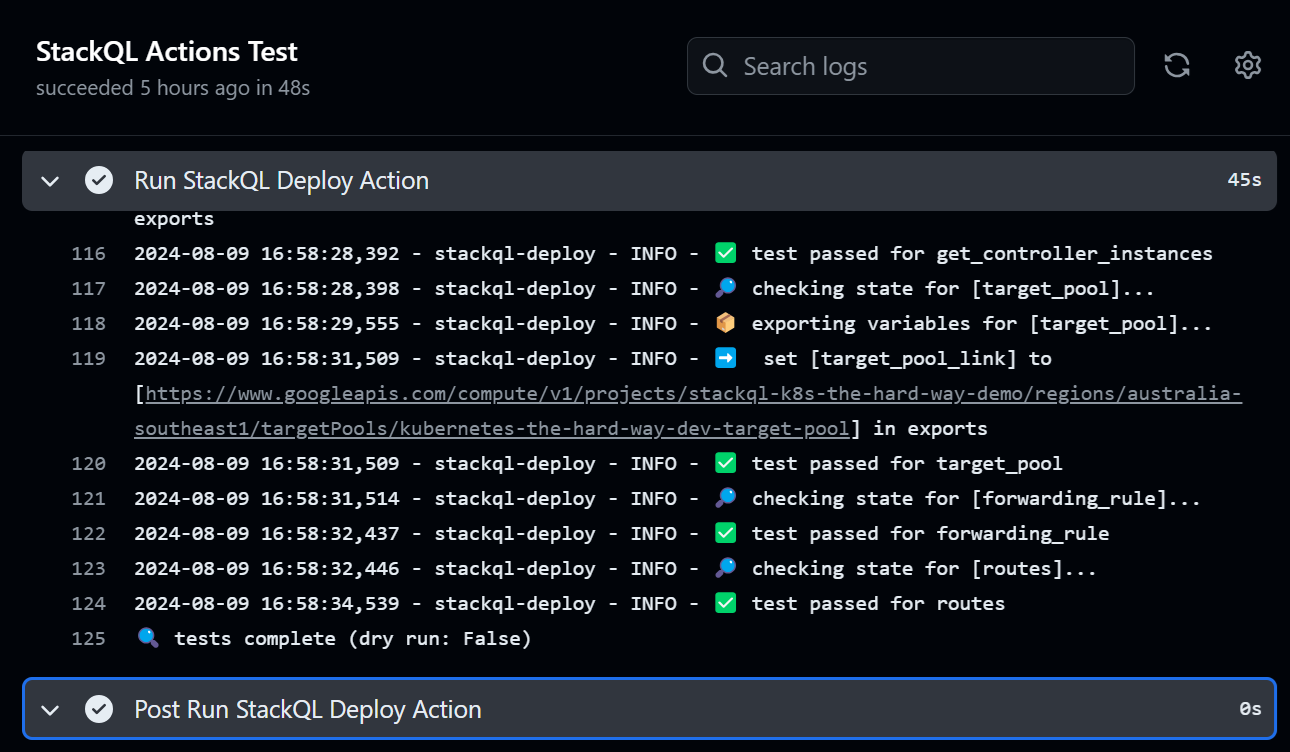stackql-deploy is a multi-cloud resource provisioning framework using stackql. It is inspired by dbt (data build tool), which manages data transformation workflows in analytics engineering by treating SQL scripts as models that can be built, tested, and materialized incrementally. With StackQL, you can create a similar framework for cloud and SaaS provisioning. The goal is to treat infrastructure-as-code (IaC) queries as models that can be deployed, managed, and interconnected.
This ELT/model-based framework for IaC allows you to provision, test, update, and tear down multi-cloud stacks, similar to how dbt manages data transformation projects, with the benefits of version control, peer review, and automation. This approach enables you to deploy complex, dependent infrastructure components in a reliable and repeatable manner.
Features
StackQL simplifies the interaction with cloud resources by using SQL-like syntax, making it easier to define and execute complex cloud management operations. Resources are provisioned with INSERT statements, and tests are structured around SELECT statements.
Features include:
- Dynamic state determination (eliminating the need for state files)
- Pre-flight and post-deploy assurance tests for resources
- Simple flow control with rollback capabilities
- Single code base for multiple target environments
- SQL-based definitions for resources and tests
Installing stackql-deploy
To get started with stackql-deploy, run the following:
pip install stackql-deploy
stackql-deploy will automatically download the latest release of stackql using the pystackql Python package. You can then use the info command to get runtime information:
$ stackql-deploy info
stackql-deploy version: 1.1.0
pystackql version : 3.6.1
stackql version : v0.5.612
stackql binary path : /home/javen/.local/stackql
platform : Linux x86_64 (Linux-5.15.133.1-microsoft-standard-WSL2-x86_64-with-glibc2.35), Python 3.10.12
Project structure
A stackql-deploy project is a directory with declarative SQL definitions to provision, de-provision, or test resources in a stack. The key components and their definitions are listed here:
stackql_manifest.yml : The manifest file for your project, defining resources and properties in your stack.stackql_resources directory : Contains StackQL queries to provision and de-provision resources in your stack.stackql_tests directory : Contains StackQL queries to test the desired state for resources in your stack.
Getting started
Use the init command to create a starter project directory:
stackql-deploy init activity_monitor
You will now have a directory named activity_monitor with stackql_resources and stackql_tests directories and a sample stackql_manifest.yml file, which will help you to get started.
Usage
The general syntax for stackql-deploy is described here:
stackql-deploy [OPTIONS] COMMAND [ARGS]...
Commands include:
build: Create or update resources based on the defined stack.teardown: Remove or decommission resources that were previously deployed.test: Execute test queries to verify the current state of resources against the expected state.info: Display the version information of the stackql-deploy tool and current configuration settings.init: Initialize a new project structure for StackQL deployments.
Optional global options (for all commands) include:
--custom-registry TEXT: Specify a custom registry URL for StackQL. This URL will be used by all commands for registry interactions.--download-dir TEXT: Define a download directory for StackQL where all files will be stored.--help: Show the help message and exit.
Options for build, test, and teardown include:
--on-failure [rollback|ignore|error]: Define the action to be taken if the operation fails. Options include rollback, ignore, or treat as an error.--dry-run: Perform a simulation of the operation without making any actual changes.-e <TEXT TEXT>...: Specify additional environment variables in key-value pairs.--env-file TEXT: Path to a file containing environment variables.--log-level [DEBUG|INFO|WARNING|ERROR|CRITICAL]: Set the logging level to control the verbosity of logs during execution.
Example
Using the activity_monitor stack we created previously using the init command, we can start defining a stack and defining the associated queries; here is the manifest file:
version: 1
name: activity_monitor
description: oss activity monitor stack
providers:
- azure
globals:
- name: subscription_id
description: azure subscription id
value: "{{ vars.AZURE_SUBSCRIPTION_ID }}"
- name: location
value: eastus
- name: resource_group_name_base
value: "activity-monitor"
resources:
- name: monitor_resource_group
description: azure resource group for activity monitor
props:
- name: resource_group_name
description: azure resource group name
value: "{{ globals.resource_group_name_base }}-{{ globals.stack_env }}"
globals.stack_env is a variable referencing the user-specified environment label.
Our stackql_resources directory must contain a .iql file (StackQL query file) with the same name as each resource defined in the resources key in the manifest file. Here is an example for stackql_resources/monitor_resource_group.iql:
INSERT INTO azure.resources.resource_groups(
resourceGroupName,
subscriptionId,
data__location
)
SELECT
'{{ resource_group_name }}',
'{{ subscription_id }}',
'{{ location }}'
DELETE FROM azure.resources.resource_groups
WHERE resourceGroupName = '{{ resource_group_name }}' AND subscriptionId = '{{ subscription_id }}'
Similarly, our stackql_tests directory must contain a .iql file (StackQL query file) with the same name as each resource defined in the stack. Here is an example for stackql_tests/monitor_resource_group.iql:
SELECT COUNT(*) as count FROM azure.resources.resource_groups
WHERE subscriptionId = '{{ subscription_id }}'
AND resourceGroupName = '{{ resource_group_name }}'
SELECT COUNT(*) as count FROM azure.resources.resource_groups
WHERE subscriptionId = '{{ subscription_id }}'
AND resourceGroupName = '{{ resource_group_name }}'
AND location = '{{ location }}'
AND JSON_EXTRACT(properties, '$.provisioningState') = 'Succeeded'
Now we can build, test, and teardown our example stack using these commands (starting with a dry-run, which will render the target queries without executing them):
stackql-deploy build example_stack prd -e AZURE_SUBSCRIPTION_ID 00000000-0000-0000-0000-000000000000 --dry-run
stackql-deploy build example_stack prd -e AZURE_SUBSCRIPTION_ID 00000000-0000-0000-0000-000000000000
stackql-deploy test example_stack prd -e AZURE_SUBSCRIPTION_ID 00000000-0000-0000-0000-000000000000
stackql-deploy teardown example_stack prd -e AZURE_SUBSCRIPTION_ID 00000000-0000-0000-0000-000000000000
Give us your feedback! ⭐ us here!
